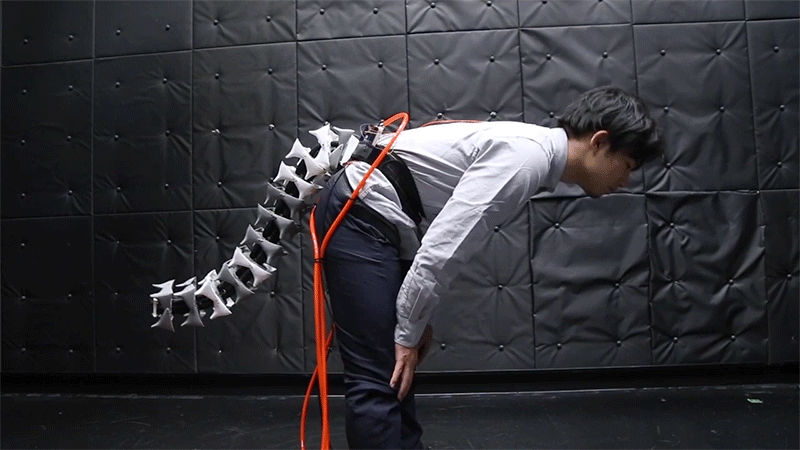Japanese scientists built a tail for humans
There are many companies in Japan that make and produce tails that people can wear, but most are used for cosplay or cosplay purposes. However, scientists at Keio University have created a tail machine for humans, with a much higher ideal to improve humanity.
The inspiration of these scientists came from watching videos of monkeys that could easily climb and jump from tree to tree. The tail of the monkey has a clear effect, not only helps them cling to the branches, but also helps to change the center of the body to better balance and have more accurate jumps.

Arque's tail helps people become more complete.
Japanese scientists named this tail Arque, which will help improve human shortcomings when there is no tail. Although jumping from branch to tree like monkey is still not recommended.
The design of the tail is based on the end joints of the seahorse tail. It is assembled from a series of plastic vertebrae linked together and can customize the amount of burning, corresponding to the length of the tail to suit each user.
Inside the tail, there are four artificial muscles that are pneumatic, can shrink or expand. Thus the tail can be controlled in different directions. Due to the current design, to use this tail requires an external compressor, but in the future scientists can change the mechanism of operation and only use a small battery.
The current application of the Arque tail is to assist workers or those who carry heavy loads. Just like an exoskeleton suit that enhances a user's muscular strength, the Arque tail creates a counterweight for users to lift heavy objects with less force.
- Tail posture reveals the mood of the cat
- Discovered to dissipate the dream of re-spending in people
- Detecting clouds of 'pig tail' on the galaxy
- The United States built unmanned aircraft to land by tail
- Prehistoric tail feathers stuck 100 million years in amber
- Intact fossil dinosaur tail discovered
- Rats born from artificial eggs
- Attach fake tail to dolphins!
- When celebrating the dog wagging its tail to the right
- Detecting giant dinosaur tails dating back 72 million years
- The secret behind the lizard's strange tail
- Discovered two new owl species in Southeast Asia
 'Fine laughs' - Scary and painful torture in ancient times
'Fine laughs' - Scary and painful torture in ancient times The sequence of numbers 142857 of the Egyptian pyramids is known as the strangest number in the world - Why?
The sequence of numbers 142857 of the Egyptian pyramids is known as the strangest number in the world - Why? History of the iron
History of the iron What is alum?
What is alum?